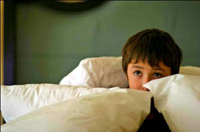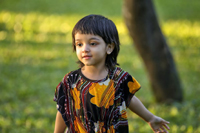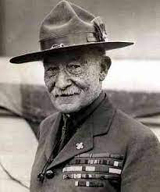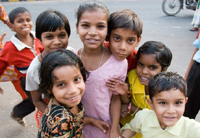Notes on counselling
Phobias in children — the price for a civilised life?
Abstract
One can finally get over fears and phobias by contacting the deepest core of the being that is connected with the Universal Truth that governs the world.
It is a counsellor’s dilemma whether to view phobias in children as a price for a civilised life. For phobias in children very often develop in the matrix of interpersonal life, in the social milieu. Did such phobias exist in primitive life when humans had not settled down for agriculture?
Take the case of school phobia. In most cases children cannot bear the separation anxiety from the mother figure. We recommend, to break the impasse, somehow tricking the child to attend school, and that actually works in many cases in the beginning. However, if left unattended, the condition becomes chronic and may turn out to be refractory. In recent times another type of school phobia has been gripping children — the phenomenon of bullying in school. Nothing seems to work here satisfactorily, for counselling sessions often prove counterproductive, as it is followed by new types of bullying. Bullying affects victims not only psychologically but also affects their immune-system. Yet an important cause that makes counselling ineffective is that many teachers are unable to be neutral or non-judgmental. The bullying children seem to successfully manipulate such teachers, who not only support them but make them class monitors and allot them lead-roles in school programmes while the hapless victims go on shuddering in fear and feel miserable with a lowering of self-esteem!
Perhaps the primitive simplicity of nature has been disturbed by our civilisational liabilities. Would the child fearing the school because of being scared by the bullies among his or her own peer group be comfortable in front of a lion’s cage in the zoo? And this is surprising for such children actually enjoy viewing animals, even caged animals in the zoo! In a kindergarten school situated in the premises which have a horse farm, children are brought to enjoy viewing the horses which remain standing in majestic poises. The children soon learn to outgrow their feelings of fear and insecurity. It is such a joy to see them standing fearlessly in front of the horses! It is a common thing to see how even infants behave fearlessly with pet dogs!
Of course there are children who are afraid of insects and lizards and other such small entities. There are children who are afraid of the loud gongs of clocks. And there are children who are afraid of ghosts and imaginary figures. Once I saw a child who broke down in extreme fear after seeing a demon in a TV advertisement and who was canvassing that what was the owner’s pride was the neighbour’s envy. In all such cases, social conditioning plays a role in the genesis of fear.
Children have a weaker constitution in comparison to adults. As the Mother explained:
“Why do children have fear? Because they are weak. Physically they are weaker than the grown-ups around them and, generally, they are also weaker vitally and mentally (1).”
It is therefore not surprising that children become victims of social conditioning too easily. So many times when mothers complained that their children always felt scared in strange situations, I have enquired if the parents were putting on the night-lamp when children went to sleep. Surprisingly, many replied in the affirmative. Another civilisational menace! Children should not be denied enjoyment of the dark. Actually they should learn to sharpen their sensory acuity in the dark. This is the reason we play ‘Blind man’s buff’ or enjoy the hide and seek game while remaining concealed in a corner that may be dark.
There was this case of a four-year-old girl who was afraid of many things and that surprised everyone. She was frightened of guests, of crowds, of teachers and even of her peer-group. She was afraid to climb stairs. She was afraid of fire-crackers. Yet she was never afraid of lightning and thunder storms though severe lightning near her home had actually been so disruptive as to strike a number of victims dead. Ostensibly, fire-crackers were made by human beings while lightning is Nature’s own phenomena. One could clearly delineate the social dimension of phobia even in a four-year-old child!
We have all our counselling techniques to deal with such children. But something else could be added outside the counselling space. Children could be exposed to nature in myriad ways. This would include exposure to trees and shrubs, flowers and butterflies, lakes and rivers, seas and mountains, climbing trees to watch nests of birds and enjoying the zoo! Not only would such exposure of nature make the child secure and fearless, it would simultaneously serve another great cause. As Lord Baden Powell, founder of the Boy Scouts movement, used to repeatedly say that more than going to a church or temple, an exposure to Nature would automatically and spontaneously induce a reverence for the Supreme. And that would be the main motivator to rise above phobias! It is the spiritual dimension that surpasses all our behavioural techniques in making our children warriors over fears and phobias.
Children do not understand that their fears are unreasonable but which adults with phobias recognise. Naturally the most common behavioural attitude shown is avoidance. One tries to avoid situations which are stressful. It is here that parents and teachers can come forward to lead by example. Avoidance is an atavistic trait for human beings, unlike animals, which turn around to face dangers. One common example I have found useful to explain to children that among the initial inventions made by human beings was the boat. Imagine how fearless was the attitude to make a boat to sail in the sea.
And I find Sri Aurobindo’s poem, ‘To the Sea’ (2) very useful to enforce my point. The human being takes up the challenge to sail the boat by winning over the sea. If perchance he fails in his mission, he would get drowned but then he would be bearing the entire sea on his bosom – in any case he does not lose! It is such a beautiful analogy and is so effective in counselling to help insecure children to get over their avoidance behaviour.
Then there are children who classically suffer from social phobias either in social settings (with unfamiliar peers and not only unfamiliar adults) or in performance situations (sports, music). There are children who can feel embarrassed to speak out in the classroom, answer questions or recite. There are others who might feel uncomfortable to attend social gatherings or even indulge in extra-curricular activities. One key breakthrough can happen if such children are facilitated to enjoy peer-group activities. Baden Powell took the cue that children and adolescents like to get organised in natural gangs and it is the gang-spirit that can help them to face adventure by overcoming insecurities. This is how the Boy Scouts became a successful character-building movement that complemented school education. One has to work on the positive potentialities of childhood. Too many reminders of difficulties faced do not help but may instead make parents unwilling collaborators in reinforcing such unhealthy behaviour.
The feeling of insecurity gets invariably linked up with the feeling of low self-esteem in growing children This is what makes the child suffer more. Fearlessness needs to be consciously cultivated and it is here that parents and teachers have to design innovative ways that would be unique for every child. For each child has a different background and a different story to tell. There are many children who actually became insecure and started having phobias after being insensitively handled not only by parents but by teachers at school !
The Mother elaborates the spiritual agenda that overrides all fears and phobias, “Fear stems from a sense of inferiority. However, there is a way to be free from it: it is to have faith in the Divine Grace and to rely on It to protect you in all circumstances.
The more you grow up, the more you will get over your fear if you let the contact with your soul develop in you — that is to say, with the truth of your being — and if you always strive that all you think, all you speak, all you do should be more and more the expression of this deep truth.
When you will consciously live in it, you will fear nothing any longer, in any domain of your being, because you will be united with the universal Truth which governs the world (3).”
The Mother’s guidance has assumed pragmatic significance in the Covid-19 pandemic. Children have suddenly begun to get scared of death. Seeing the devastation all around, many children in high-risk zones began to be scared not only of their dying but of the situation they would have to face if their parents did not survive. This anxiety is so deep-rooted that mere allaying by counselling-sermons does not work. It is only by facilitating a contact with the deepest truth of the being that one can develop a true sense of security. Sceptics would frown that such techniques are for adults. That is not true. The psychic being or soul-element is sensitively palpable in children who are free from the jargon of the intellect and the dissonance of reason. They are more receptive to attempts that touch their deepest core.
References
1. The Mother. The Collected Works of the Mother, Volume 12. Cent ed. Pondicherry: Sri Aurobindo Ashram Trust; 1978, p. 125.
2. Sri Aurobindo. The Complete Works of Sri Aurobindo, Volume 2. Pondicherry: Sri Aurobindo Ashram Trust; 2009, pp. 207-08.
3. The Mother. Collected Works, Volume 12, p. 125.
Dr. Soumitra Basu, a practising psychiatrist and member of SAIIIHR, is the Director of a school of psychology, Integral Yoga Psychology. He is also one of the editors of NAMAH.
Share with us (Comments,contributions,opinions)
When reproducing this feature, please credit NAMAH,and give the byline. Please send us cuttings.





